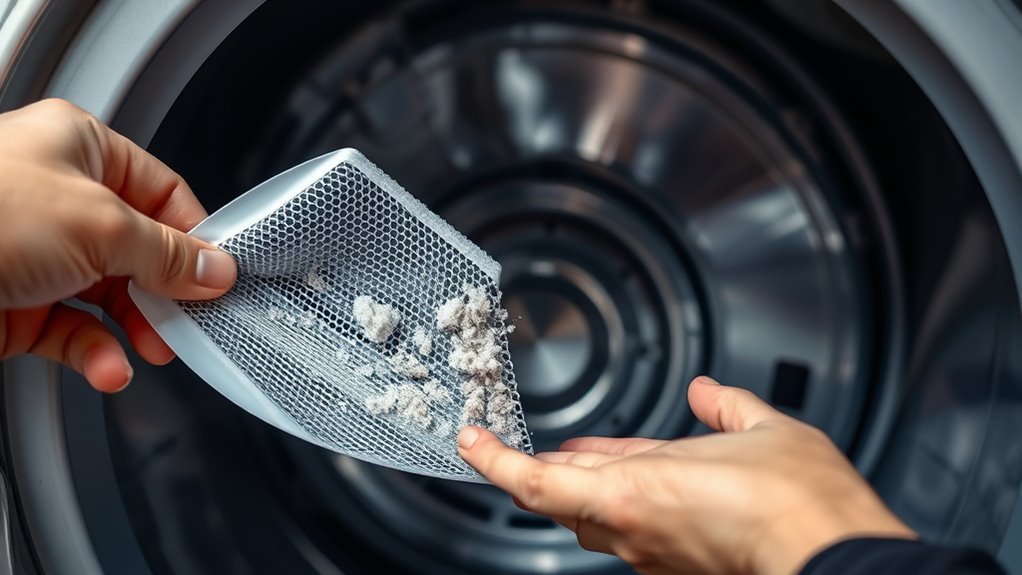To keep your dryer running safely and efficiently, you should regularly clean the lint filter after each load and clear any lint buildup from the sensors using a soft cloth and mild cleaner. Occasionally disconnect the vent to remove trapped lint, which improves airflow and drying times. Proper maintenance prevents potential fires and helps your dryer last longer. Keep these tips in mind to guarantee your appliance performs its best—there’s more helpful advice ahead.
Key Takeaways
- Remove lint from the filter after each load to ensure proper airflow and dryer efficiency.
- Gently clean moisture sensors with a soft cloth and mild cleaner to maintain accurate moisture detection.
- Periodically disconnect and clean the vent to prevent lint buildup and improve drying performance.
- Use a vent brush or vacuum attachment to remove stubborn lint inside the vent or around sensors.
- Follow manufacturer guidelines for routine maintenance to prolong your dryer’s lifespan and ensure safety.

Regularly cleaning your dryer’s lint filter and sensors is essential for safe and efficient operation. When you forget to clear the lint filter after each load, lint can accumulate, restricting airflow and making your dryer work harder than necessary. This not only increases energy consumption but also raises the risk of overheating and potential fires. To prevent this, make a habit of removing lint from the filter every time you use the dryer. But don’t stop there—clean the dryer vent periodically as well. A clogged vent can trap hot air and moisture, causing your dryer to run longer and less efficiently. You can do this by disconnecting the vent from the back of the dryer and removing any lint buildup inside. Using a vent brush or vacuum attachment helps dislodge stubborn lint, ensuring proper airflow. Maintaining a clear dryer vent is one of the simplest ways to improve your dryer’s performance and safety. Additionally, considering the air quality considerations related to your laundry area can help prevent dust and lint buildup from circulating in your home environment. Moisture sensors are another critical component that often gets overlooked. These sensors detect when clothes are dry and signal the dryer to turn off, saving you energy and preventing over-drying. Over time, moisture sensors can become coated with detergent residue, fabric softener buildup, or lint, which hampers their ability to function correctly. To keep them working properly, gently clean the sensors with a soft cloth and a mild cleaner, ensuring no residue remains. When moisture sensors are dirty, your dryer may either shut off prematurely or continue running long after your clothes are dry, wasting energy and increasing wear on the machine. Regular cleaning of these sensors ensures they accurately detect moisture and help you save on electricity bills. Furthermore, always check the lint filter and moisture sensors before starting a load. A clean lint filter and sensors mean better airflow and more accurate moisture detection, which leads to faster drying times and less energy consumption. Remember that a dirty lint filter or faulty sensors can cause your dryer to overheat or take longer to dry clothes, both of which can lead to damage or safety hazards. Incorporating routine cleaning into your laundry schedule—such as following manufacturer guidelines for maintenance—it’s quick, easy, and greatly improves your dryer’s efficiency. By doing so, you’re not just prolonging the lifespan of your appliance but also reducing the risk of fire hazards caused by lint buildup or sensor malfunction. Regular maintenance like this ensures your dryer runs smoothly, keeps your laundry routine hassle-free, and safeguards your home.
Frequently Asked Questions
How Often Should I Replace My Dryer’s Lint Filter?
You should replace your dryer’s lint filter every one to two years for ideal lint filter maintenance. Regularly check for damage or tears and replace if necessary. Keeping sensors calibrated helps your dryer run efficiently, so follow sensor calibration tips to guarantee accurate detection of lint buildup. Doing this maintains airflow, prevents fires, and keeps your dryer operating smoothly. Don’t forget to clean the filter after every load for best results!
Can I Clean the Sensors With Household Cleaning Products?
You shouldn’t use household cleaning products on your dryer’s sensors, as they can damage the delicate components. Instead, opt for a soft cloth slightly dampened with water or a gentle, sensor-safe cleaner recommended by the manufacturer. Proper sensor maintenance guarantees your dryer runs efficiently and safely. Avoid harsh chemicals to prevent corrosion or sensor malfunction, and always follow your dryer’s cleaning instructions for the best results.
What Signs Indicate My Dryer Sensors Need Recalibration?
You’ll notice sensor calibration issues if your dryer displays error indicators like inconsistent drying times or fails to detect moisture correctly. If clothes seem damp even after cycles, or the dryer stops prematurely, it’s a sign you need to recalibrate the sensors. Regularly check for error indicators, and if they persist, follow your dryer’s calibration instructions or contact a professional to guarantee accurate sensor calibration and peak performance.
Is It Safe to Use Compressed Air to Clean the Sensors?
Using compressed air to clean your dryer sensors can be safe if you do it carefully, but there’s a risk of sensor damage if you use too much force or hold the can too close. Always keep the compressed air can upright and use short bursts. This minimizes the chance of damaging the sensors and guarantees you clean without causing any harm to your dryer’s delicate components.
Do Different Dryer Brands Require Different Cleaning Techniques?
Imagine you own a Samsung dryer, and you notice different brand-specific maintenance needs. You should know that cleaning method variations exist, so each brand may require unique techniques. For example, LG dryers might need gentle brush cleaning for sensors, while Whirlpool models could involve specific lint filter procedures. Always consult your user manual or manufacturer’s guidelines, as different brands do indeed require tailored cleaning approaches to guarantee excellent performance and safety.
Conclusion
By regularly cleaning your dryer’s lint filter and sensors, you’re giving your appliance the TLC it needs to run smoothly—think of it as giving your dryer a gust of fresh air. This simple upkeep keeps your laundry smelling fresh and your energy bills in check. Don’t let dust and lint build up like unwanted weeds; tend to your dryer, and it’ll reward you with efficient, trouble-free drying every time. Your dryer will thank you for it!









